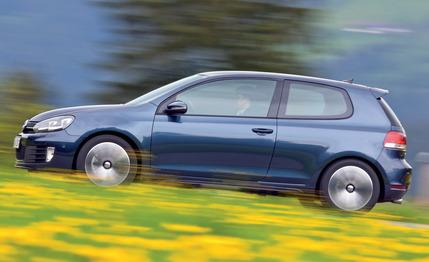 First Drive Review
First Drive Review
The year was 1982. One year before the almost-legendary Golf I—a.k.a. Rabbit—was discontinued in the European market, Volkswagen engineers decided to have a little fun with a diesel engine. There had been diesel-powered Golfs for years that offered acceptable power and great fuel economy, but they weren’t much fun.
The addition of an exhaust-driven turbocharger bumped output from 53 hp to 69 hp and transformed the Golf diesel into such a torquey and spirited little car that VW styled it almost exactly like the GTI, leading to the GTD moniker. The few changes to the GTI’s look included a silver stripe around the grille—instead of a red one—and different wheels. VW continued to offer a GTD for the second-generation Golf, but the GTD badge was finally discontinued for the third generation. In its place, VW came up with something even better: the strictly technical TDI moniker. It stood for a new generation of direct-injection turbo-diesels and was cool enough to separate the oil-burning Golf from the rest of the lineup. These diesels were so fast that “TDI” took over as the badge of supremacy in the diesel world.
Looking the Part
Today, virtually every automaker is offering high-powered diesels, so it seems like a good time to bring the GTD label back. VW thus aims to position the Golf ahead of the competition and to play to the somewhat historic theme. The cost cutters are happy because all the necessary ingredients were already sitting on the shelves, including the 2.0-liter TDI turbo-diesel inline-four.
For the GTD, VW first added the GTI’s body kit, including the large front intake with vertical fog lights and the sporty rear bumper. The rear diffuser is altered with double exhaust pipes on the left side versus the GTI’s symmetrical dual outlets. And the honeycomb mesh grille, another GTI part, is graced with silver stripes in place of red ones—a flashback to the first-generation GTD, just like the seats with their silver lining in place of the GTI’s red accents. Seventeen-inch alloys are standard, and 18-inchers are optional; their design differs from those on the GTI, too.
Reviving the Oil Burner
To the casual observer, however, the GTD looks just like a GTI; it’s clearly different from lesser Golfs. But when the GTD flashes its optional xenon headlights in your rearview mirror, should you move over to the right lane, or is the GTD all show? If you’re not in a sports car or a powerful sedan, chances are you won’t be able to keep up. The GTD doesn’t run out of steam until 138 mph. A unique sound clearly sets the 170-hp GTD apart from the 140-hp TDI that is ubiquitous across VW’s lineup and offered in the U.S.-market Jetta. The noise is certainly pleasing, but we’re not sure it won’t get obnoxious over an extended high-speed journey. At 258 lb-ft, torque output bests the lower-powered TDI by 22.
The GTD’s TDI engine is equipped with larger-diameter injectors and a bigger turbocharger that generates up to 36 psi of boost. But it was not specifically developed for the GTD. This engine has been available for some time in the European-market Passat and CC. It powers VW’s Jetta TDI Cup spec racers, too. With the next upgrade, planned for 2010 and meeting Euro 6 emissions requirements, we expect output to increase to the neighborhood of 180 to 190 hp.
With the standard six-speed manual, VW claims the GTD accelerates from 0 to 62 mph in 8.1 seconds, and fuel economy is rated at 44 mpg in the combined European cycle. The optional six-speed, dual-clutch automated manual gearbox (DSG) has no negative effect on acceleration, yet top speed drops to 137 mph and fuel economy falls to 42 mpg. Both transmissions work well, but compared with in the GTI, the dual-clutch loses some appeal. It is not tuned to blip the throttle of the oil burner, and therefore, the sound effects that characterize the DSG-equipped GTI are lost.
Fun and Frugal Character
The standard suspension of the GTD is tuned slightly sportier than that of the regular Golf TDI. The GTD is lowered by 0.6 inch—not quite as much as the GTI, which is lowered by 0.9 inch compared with the standard Golf. We drove the GTD with the optional adaptive suspension. Comfort mode works well on the freeway, but once you hit twisty roads, you’re well advised to choose the sport setting to sharpen responses and adjust the steering, which then requires a slightly firmer grip. The chassis manages to mask the heavy engine rather well, but we hope the GTI’s XDS electronic differential will eventually be offered for quicker exits from tight corners. VW’s 4MOTION all-wheel-drive system won’t be offered any time soon, either.
The GTD is a noticeable step up from the 140-hp Golf TDI, which is not as well equipped and priced considerably lower. But it is no match for the 200-hp turbo four in the more powerful yet less expensive GTI. However, the GTD’s greater starting price (€27,475 in Germany) can be offset somewhat by its fuel economy, especially if you have a heavy right foot. Driven carefully, the GTD uses about 20-percent-less fuel than its gasoline-fueled twin. Go BMW hunting, and the GTD should still get you at least 30 mpg—nearly double what you would get in a similarly driven GTI.
But we suggest another comparison. Look at the GTD as an alternative to a gas-electric hybrid, such as a loaded Toyota Prius or the new Lexus HS250h. Why do we prefer the GTD? Because you wouldn’t even consider chasing a 3-series BMW in one of those.